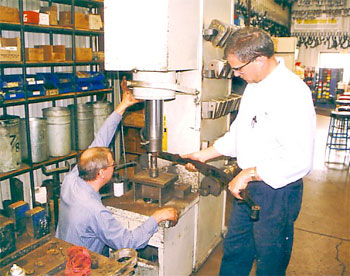Re-Arching Leaf Springs a Lost Art
The condition of leaf springs on a collector car can affect its appearance and driving safety. A car that sags to one side or in the back doesn’t look right. Worn-out old springs can also affect handling, steering or braking.
Reproductions, Rebuilding and Re-arching
Reproduction springs may be available for some old cars. Most will fit and function like “factory” springs, but there may be differences in appearance or construction. For example: The grooved spring steel used on 1950s-1960s American cars is no longer available. Reproduction springs may be made of smooth steel.
Rebuilding a leaf spring involves disassembling the leaves by removing the center bolt and clips that hold them together. There will be insulators between the leaves, plus bushings and other hardware. When springs are rebuilt, all these parts can’t be re-used; they have to be replaced. The parts can cost $200 or more, depending on the type of car. After the parts are disassembled, the individual leafs are re-arched and the spring is refinished and re-assembled.
Re-arching a leaf spring can be done by “cold” or “hot” methods. When a spring is re-arched, the leaves are returned to the original shape. Some people say re-arching springs doesn’t work well. Others point out that shops have been re-arching springs on heavy trucks for 70 years and truck drivers believe in the practice. If the spring steel hasn’t lost its “temper,” it can probably be re-arched.
Cold Re-arching
“Cold setting” a spring requires special equipment. It is clamped in a hydraulic vise to allow safe disassembly. The leaves are separately laid across a pair of arbors and a hydraulic press presses down on the leaf, between the blocks, applying pressure fully across the leaf, at a 90-degree angle to its length.
A specially trained technician starts at one end of the leaf and presses down on numerous points while moving across the length of the leaf. The technician will space out the pressure points about the distance between the arbors with each press of the machine. A rhythm must be developed to do this just right. Pressure is applied from one end to the other along the entire length.
When proper pressure is used, you’ll see the ends of the leaves move about an inch with each press. Each leaf is re-arched separately. The technician knows how to avoid putting too much pressure at one point and breaking a leaf. At the end, each leaf will have the same arch. They will then be re-assembled in their original position and orientation with new center bolts and tie clamps.
The cost of having two small leaf spring re-arched recently was $100. This seemed like an excellent bargain for three hours of work. If you figure in new bushings, liners, center bolts, clips, rust removers and rust-preventative paint, the total expense for cold setting and restoring these springs will be about $500.
Heat-Treating a Spring
The spring steel used to make springs has “memory” that makes it want to return to its shape. The heat-treating process erases the spring’s memory by annealing each leaf in the spring pack individually, reshaping it and re-heat treating it. After disassembling the pack, each leaf is heated to at least 1,650 degrees Fahrenheit to clear its memory.
A pattern is used to re-shape the hot spring leaf to its correct arch. It is then quenched in special oil to cool it rapidly. It is now shaped correctly, but the heating and quick-cooling process creates hardness and brittleness that has to be removed. The leaf is re-heated to at least 950 degrees for a set time to draw out some of the hardness. It is cooled slowly and then shot-peened to relieve stress.
Few companies have the equipment and know how required to heat-treat a spring. This makes the process much more costly than cold setting. A pair of leaf springs was recently re-arched by the cold setting process at a cost of $100. It would cost a minimum of $450 to have the same job done by the heat-treating method.
John “Gunner” Gunnell is the automotive books editor at Krause Publications in Iola, Wis., and former editor of Old Cars Weekly and Old Cars Price Guide.


